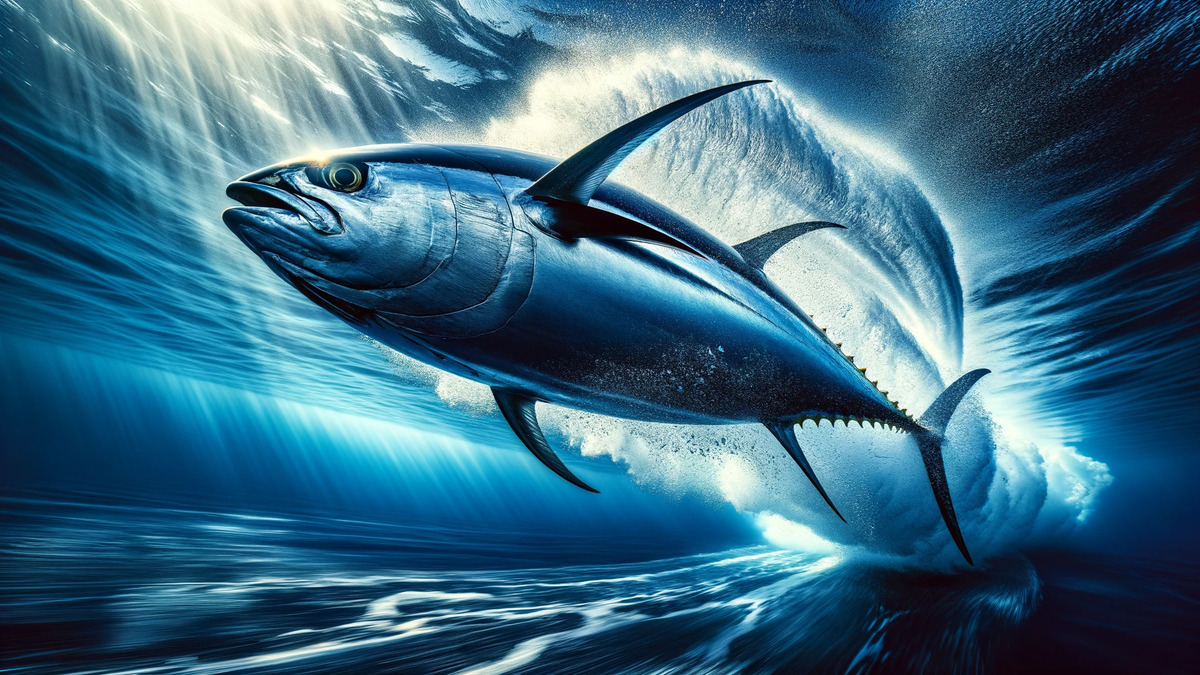Over the speed limit Unknown tuna small tuna stories
Tuna are often large fish but very agile swimmers and can reach speeds of up to 75 km/h. This allows them to evade predators and hunt prey efficiently.
They are also one of the few warm-blooded animals that can regulate their body temperature. This feature allows them to survive in a wide range of climates, from tropical to temperate waters.
Unlike white fish, the musculature of tuna is pink to dark red in colour. This colour is due to the high content of myoglobin, an oxygen-binding molecule, in tuna muscle tissue, which enables it to swim long distances at high speed. This can be said to be the same as the muscles of athletes with a balance between the white muscles of instantaneous power and the red muscles of long-distance runners.
Of course, it is not just about the musculature. Their streamlined body shape and powerful tail make them one of the most efficient swimmers in the sea.
Their courtship behaviour is just amazing. This is more of a video than an explanation. Tuna Tornado!
In terms of diet, they feed mainly on other fish and squid, which contributes to their unique flavour and high protein content.
They are fast swimmers as well as fast growers. Some species, such as yellowfin tuna, grow up to 100 kg in just 18 months.
Furthermore, unlike many other fish species, tuna need to keep moving while at rest. This is a behaviour known as ram ventilation. This is to ensure that water is constantly flowing over the gills to provide oxygen.
Tuna play an important role in the global economy and are a valuable seafood species in many cultures, especially in Japan, where they are often used in dishes such as sushi and sashimi. The bluefin tuna, the largest and most coveted of the tuna species, can fetch incredibly high prices in the market, with one tuna fetching up to 100 million yen.
A threat to tuna is the build-up of mercury in their tissues. This is due to bioaccumulation, whereby the tuna is a top predator and therefore ingests all the mercury accumulated by the smaller organisms it preys on.
In relation to their reproductive habits, tuna reproduce by discharge spawning, in which the female releases millions of eggs into the water to be fertilised by the male. This method does not guarantee high survival rates, but under the right conditions it can produce a large number of offspring.
Contrary to the usual solitary behaviour of many larger fish, certain tuna species, such as skipjack, are known to form schools with other species. These schools often contain thousands of individuals. Remarkably, these schools are highly organised, with fish synchronising their swimming to increase efficiency and protect themselves from predators.
The social structure of tuna schools is complex and not fully understood. Although they form large schools, these groups are not always permanent and individuals are often interchanged between different schools.
The name “tuna” actually refers to several species of fish in the mackerel family, rather than a single species. The skipjack is also a tuna.
They have a unique eye anatomy and highly developed vision adapted to their lifestyle. Unlike many other fish, they can see colours. Their vision is particularly attuned to detect objects against the blue background of the open sea.
Notably, they have a higher metabolic rate than other fish, allowing them to swim and hunt incessantly. This high metabolic rate also requires them to consume large amounts of food to maintain their energy levels.
To find prey, tuna use a specialised sensory organ called the lateral line. The lateral line detects vibrations and pressure changes in the water and helps them to locate schools of fish and individual prey.
Species such as bluefin tuna and yellowfin tuna are very popular with sport fishermen and their size and speed make them a challenging and valuable catch. Large tuna fishing tournaments are also held in many parts of the world, with large cash prizes for the biggest catches.
It is interesting to note that different tuna species have different life spans. For example, the average lifespan of albacore tuna is about 11-12 years, while bigeye tuna can live up to 15 years. The oldest recorded age for bluefin tuna is 26 years.
They are not only found in the open sea. Certain species, such as bluefin tuna, actually inhabit shallow coastal waters. Juveniles of many species spend their early life stages in coastal waters before venturing into deeper waters. Tuna have also been found in the cold waters off Iceland and Greenland. As already noted, their body temperature maintenance characteristics indicate a wide range of tolerance of their habitat.
They are an integral part of the ecosystem and play a role as both predator and prey in the marine food web. Tuna feed on a variety of small fish and invertebrates and are preyed upon by larger marine organisms such as sharks and killer whales, as well as seabirds.
One species of tuna, the southern bluefin tuna, is known to make the longest migration of any fish, with individuals tagged in New Zealand travelling over 12,000 km before being recaptured off South Africa. Such long migrations are undertaken to find abundant food sources and suitable breeding grounds.
Some tuna are cooperative hunters. Specifically, they take turns to feed after swarming small fish into a compact ball. This strategy increases hunting efficiency and allows them to catch large numbers of prey in a short time.
Finally, despite their size, tunas lay the smallest eggs of any fish, at just 1 mm in diameter. This contrasts with the size of the adult fish. This is a testimony to the remarkable growth and development of this creature throughout its life.
Trivia as sushi food Personal observation: the Atlantic bluefin tuna is the most expensive fish
Tuna migration routes can span the entire ocean and some species, such as the Atlantic bluefin tuna, are known to cross the Atlantic Ocean several times a year.
The Atlantic bluefin tuna is the largest species of tuna, larger than the Pacific bluefin tuna.
Hon tuna, the highest quality tuna in sushi items, is bluefin tuna. Incidentally, the most expensive tuna in Japan is, in descending order of price, hon tuna, southern bluefin tuna, bigeye tuna and yellowfin tuna, and finally albacore (albacore) tuna.
This is almost perfectly proportional to size.
We can consider this by analogy, assuming that price, size and taste are perfectly proportional to each other.
Atlantic bluefin tuna is larger than Pacific tuna. Therefore, it may be that Atlantic bluefin tuna is the tastiest.
But only if the assumption is correct. It is only in recent years that tuna has become a representative of high-end sushi and sashimi. In the past, it was known as “under-fish” and was far more expensive than today’s tuna. Sardines and eels are also expensive in Japan today, but used to be relatively cheap. Therefore, it may be a simple matter of branding and demand rather than taste.
Japanese bluefin tuna from Ohma in Aomori is considered the best bluefin tuna from the Pacific Ocean and is prized in Japan alongside Kobe beef. It is competed for by seafood wholesalers and high-end sushi restaurants and, as mentioned above, can fetch as much as 100 million yen.
However, it makes more sense to think of this as a marketing expense rather than a price for its taste. The 100 million yen bid is filmed by all Japanese television stations and broadcast in length on the week’s news shows. The cost-effectiveness of the publicity is outstanding.
The tuna here could be priced at around 1 billion yen. It’s almost like a shark now.



コメント